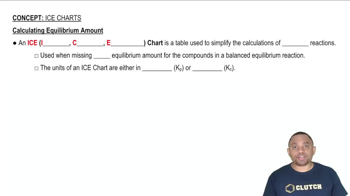At 80°C, 𝐾𝑐 = 1.87×10−3 for the reaction PH3BCl3(𝑠) ⇌ PH3(𝑔) + BCl3(𝑔) (a) Calculate the equilibrium concentrations of PH3 and BCl3 if a solid sample of PH3BCl3 is placed in a closed vessel at 80°C and decomposes until equilibrium is reached. (b) If the flask has a volume of 0.250 L, what is the minimum mass of PH3BCl3(𝑠) that must be added to the flask to achieve equilibrium?
Ch.15 - Chemical Equilibrium
Chapter 15, Problem 55
At 2000°C, the equilibrium constant for the reaction 2 NO(𝑔) ⇌ N2(𝑔) + O2(𝑔) is 𝐾𝑐 = 2.4×103. If the initial concentration of NO is 0.175 M, what are the equilibrium concentrations of NO, N2, and O2?
 Verified step by step guidance
Verified step by step guidance1
Write the balanced chemical equation: 2 \text{NO}(g) \rightleftharpoons \text{N}_2(g) + \text{O}_2(g).
Set up an ICE (Initial, Change, Equilibrium) table to track the concentrations of each species. Initially, [NO] = 0.175 \text{ M}, and [N_2] = [O_2] = 0 \text{ M}.
Define the change in concentration for NO as -2x, for N_2 as +x, and for O_2 as +x, where x is the change in concentration at equilibrium.
Express the equilibrium concentrations in terms of x: [NO] = 0.175 - 2x, [N_2] = x, [O_2] = x.
Substitute these expressions into the equilibrium constant expression: K_c = \frac{[N_2][O_2]}{[NO]^2} = \frac{x \cdot x}{(0.175 - 2x)^2} = 2.4 \times 10^3, and solve for x.

Verified video answer for a similar problem:
This video solution was recommended by our tutors as helpful for the problem above.
Video duration:
5mWas this helpful?
Key Concepts
Here are the essential concepts you must grasp in order to answer the question correctly.
Equilibrium Constant (Kc)
The equilibrium constant (Kc) is a numerical value that expresses the ratio of the concentrations of products to reactants at equilibrium for a given reaction at a specific temperature. For the reaction 2 NO(g) ⇌ N2(g) + O2(g), Kc = [N2][O2]/[NO]^2. A larger Kc value indicates that products are favored at equilibrium, while a smaller Kc suggests that reactants are favored.
Recommended video:
Guided course

Equilibrium Constant Expressions
ICE Table
An ICE table (Initial, Change, Equilibrium) is a tool used to organize the concentrations of reactants and products in a chemical reaction at different stages. It helps in calculating the changes in concentration as the system reaches equilibrium. By filling in the initial concentrations, the changes that occur, and the equilibrium concentrations, one can systematically determine the equilibrium state of the reaction.
Recommended video:
Guided course

ICE Charts and Equilibrium Amount
Stoichiometry
Stoichiometry involves the quantitative relationships between the amounts of reactants and products in a chemical reaction, based on the balanced chemical equation. In the reaction 2 NO(g) ⇌ N2(g) + O2(g), stoichiometry allows us to relate the change in concentration of NO to the formation of N2 and O2, using the coefficients from the balanced equation to determine how much of each species is present at equilibrium.
Recommended video:
Guided course

Stoichiometry Concept
Related Practice
Textbook Question
Textbook Question
At 25°C, the reaction CaCrO4(𝑠) ⇌ Ca2+(𝑎𝑞) + CrO42−(𝑎𝑞) has an equilibrium constant 𝐾𝑐 = 7.1×10−4. What are the equilibrium concentrations of Ca2+ and CrO42− in a saturated solution of CaCrO4?
Textbook Question
For the equilibrium Br2(𝑔) + Cl2(𝑔) ⇌ 2 BrCl(𝑔) at 400 K, 𝐾𝑐 = 7.0. If 0.25 mol of Br2 and 0.55 mol of Cl2 are introduced into a 3.0-L container at 400 K, what will be the equilibrium concentrations of Br2, Cl2, and BrCl?
1
views
Textbook Question
At 373 K, 𝐾𝑝 = 0.416 for the equilibrium 2 NOBr(𝑔) ⇌ 2 NO(𝑔) + Br2(𝑔) If the equilibrium partial pressures of NOBr(𝑔) and Br2(𝑔) are both 0.100 atm at 373 K, what is the equilibrium partial pressure of NO(𝑔)?
